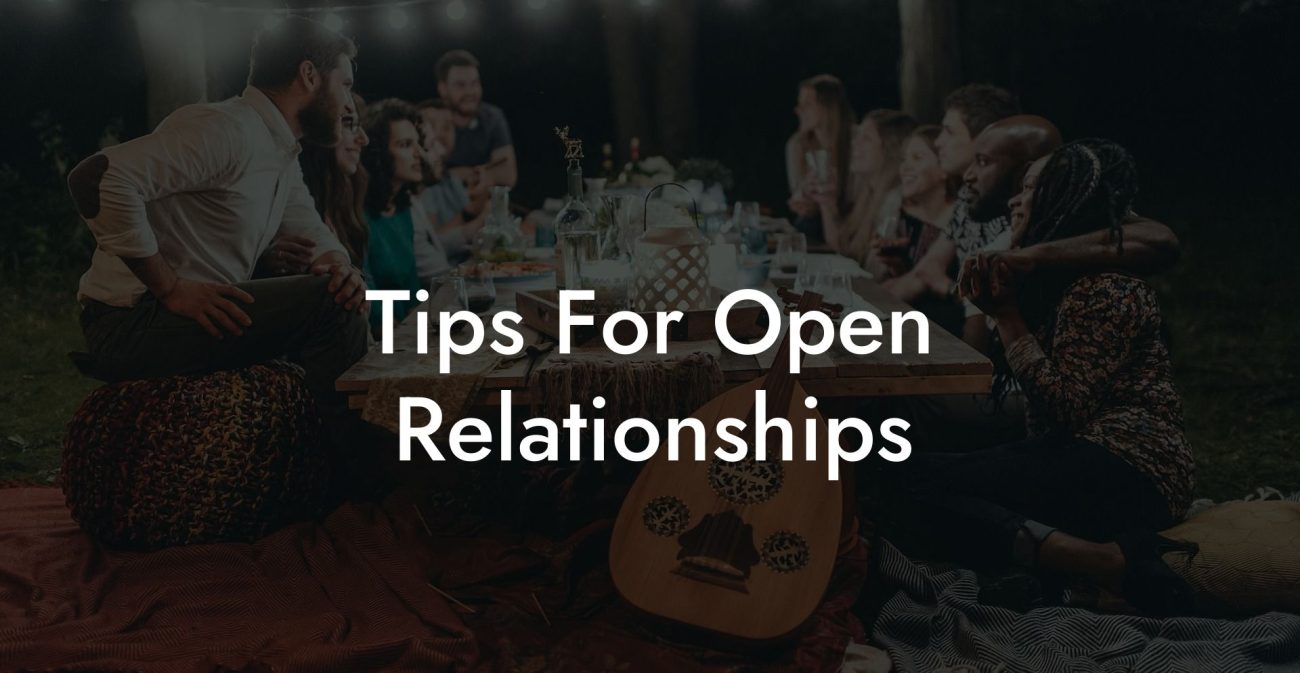Guide to Polyamory Boundaries Examples

Imagine a vibrant, sprawling garden where every relationship is a unique flower, each nurtured with its own set of rules and care routines. Now, imagine that garden is your polyamorous life, bursting with diverse connections that require thoughtful, deliberate boundaries to flourish. In this guide to polyamory boundaries examples, we’re diving into the art of drawing the lines that protect your emotional well-being while allowing love to blossom in every direction. Get ready for an outrageous, unforgettable journey through the practical, creative, and sometimes wild world of setting boundaries in polyamorous relationships.
Have you ever wondered if monogamy is just a stupid little experiment? Open relationships, polyamory, relationship anarchy...find out which relationship dynamic suits you best with our one minute relationship test. See if you are just conforming to "societal norms". Reveal your truth >>
Quick Links to Useful Sections
- Understanding the Importance of Boundaries in Polyamory
- What Are Boundaries and Why Do They Matter?
- The Role of Boundaries in Building trust
- Types of Boundaries in Polyamorous Relationships
- Emotional Boundaries
- Physical Boundaries
- Time and Scheduling Boundaries
- Financial and Logistical Boundaries
- Communication Boundaries
- Examples of Polyamorous Boundaries in Action
- Example 1: The Primary and Secondary Arrangement
- Example 2: Open Disclosure and Privacy Boundaries
- Example 3: Time Management Boundaries
- Example 4: Financial and Logistical Boundaries
- Strategies for Establishing and Enforcing Boundaries
- Start with Self-Reflection
- Engage in Open Dialogue
- Create Written or Digital Agreements
- Regularly Revisit and Revise Boundaries
- Seek External Support When Needed
- Real-Life Stories and Testimonials
- Case Study: Jamie’s Boundary Breakthrough
- Case Study: Taylor’s Journey to Emotional Clarity
- Expert Insights on Polyamory Boundaries
- FAQ: Your Polyamory Boundaries Examples Questions Answered
Understanding the Importance of Boundaries in Polyamory
What Are Boundaries and Why Do They Matter?
Boundaries are the invisible guidelines that define what is acceptable and what isn’t in any relationship. In the context of polyamory, boundaries serve as the glue that holds multiple relationships together by ensuring that every partner’s needs, desires, and limitations are respected. They help to prevent misunderstandings, reduce feelings of jealousy, and create a safe space for open communication.
Without clear boundaries, the complexities of managing multiple romantic or sexual relationships can quickly lead to emotional overload, miscommunication, and even resentment. Boundaries are not about control; they’re about mutual respect and the protection of everyone’s well-being. They allow each individual to express their needs and ensure that all partners feel valued and secure.
The Role of Boundaries in Building trust
In any relationship, trust is built on consistency, reliability, and open dialogue. For polyamorous individuals, trust is even more crucial because it underpins the entire network of relationships. When boundaries are clearly defined and consistently honored, they provide a framework that helps to build and maintain trust. This trust is the foundation for deep emotional connections, ensuring that everyone feels safe and understood.
Think of boundaries as the rules of engagement in a game—when everyone knows and agrees to them, the game is fair, fun, and rewarding.
Types of Boundaries in Polyamorous Relationships
Emotional Boundaries
Emotional boundaries are about defining what emotional support and intimacy mean to you, and how much of it you’re willing to share with different partners. Examples include:
- Primary vs. Secondary Emotional Investment: One common arrangement in polyamory is to designate a primary partner who is the central focus of your emotional energy, while secondary partners receive a different, often lighter, level of emotional involvement.
- Privacy and Disclosure: Decide how much information about your other relationships you are comfortable sharing with each partner. For instance, you might agree that certain details remain private to protect individual identities or maintain mystery.
- Emotional Availability: Establish guidelines on how you will support each other during times of stress or need. This can include scheduling regular emotional check-ins or agreeing on how to handle conflict.
Physical Boundaries
Physical boundaries address the aspects of your relationships that involve intimacy and sexual activity. They ensure that all partners are comfortable with the level and type of physical interaction. Examples include:
- Sexual Exclusivity: Some partners may agree to have sexual relationships only with each other, while others allow for external sexual encounters. Clearly defining these expectations helps avoid misunderstandings.
- Safe Sex Practices: Agree on protocols for protecting each other’s health, such as regular STI testing, condom use, and discussing sexual health openly.
- Physical Touch and Public Displays of Affection: Determine what kinds of physical touch are acceptable in public versus private settings. For example, you might be comfortable with holding hands in public but reserve more intimate gestures for private moments.
Time and Scheduling Boundaries
Time is one of the most precious resources, and managing it well is crucial in a polyamorous setup. Time boundaries help ensure that each relationship gets the attention it deserves without overwhelming your schedule. Examples include:
- Dedicated Quality Time: Set aside specific days or hours for one-on-one time with each partner, ensuring that everyone feels valued.
- Shared Calendars: Use digital calendars to coordinate plans, avoiding conflicts and ensuring transparency about your availability.
- Alone Time: Don’t forget to schedule time for yourself. Personal space is essential for recharging emotionally and physically.
Financial and Logistical Boundaries
Money and logistics can become complicated in any relationship, especially when multiple households or shared responsibilities are involved. Examples include:
- Shared Expenses: Clearly define how costs are divided among partners, whether for living expenses, vacations, or events.
- Property and Assets: Discuss ownership and financial responsibilities openly, especially if there are plans to cohabit or share assets.
- Logistical Support: Establish who is responsible for organizing events, transportation, or childcare, if applicable.
Communication Boundaries
Communication boundaries define how much and what type of information is shared between partners. They help maintain transparency and prevent misunderstandings. Examples include:
- Frequency of Communication: Decide how often you wish to check in with each partner—this could range from daily messages to weekly video calls.
- Sharing Personal Information: Set guidelines on how much detail you provide about your other relationships, ensuring that every partner feels comfortable with the level of disclosure.
- Conflict Resolution: Establish protocols for addressing disagreements—whether it’s through scheduled discussions, mediation, or written communication—to ensure that conflicts are resolved constructively.
Examples of Polyamorous Boundaries in Action
Example 1: The Primary and Secondary Arrangement
Consider a scenario where one partner is designated as the primary, receiving the majority of emotional and practical support, while secondary partners play a more supportive role. In this case, boundaries might include:
- Exclusive Date Nights: The primary couple schedules regular, uninterrupted time together, such as a weekly date night.
- Separate Communication Channels: The primary relationship might have a private chat or email thread, while interactions with secondary partners occur through a different medium.
- Health and Safety Protocols: Agreements on sexual health measures, such as regular testing and condom use, are strictly adhered to in both primary and secondary relationships.
Example 2: Open Disclosure and Privacy Boundaries
In a network where all partners are involved in the communication process, boundaries around privacy and disclosure are essential. For example:
- Selective Sharing: You might agree that details about your intimate encounters with other partners remain private, while broader relationship dynamics are shared openly.
- Digital Privacy: Use pseudonyms or privacy settings on shared social media platforms to control what personal information is disclosed.
- Event Coordination: For social events, a designated organizer might manage the guest list and ensure that everyone’s comfort levels regarding information sharing are respected.
Example 3: Time Management Boundaries
Time management is a common challenge in poly relationships. Here’s an example of how boundaries might be set:
- Shared Calendar: All partners have access to a shared calendar where major events, dates, and availability are clearly marked.
- Rotating Schedules: If you have multiple partners, you might rotate the schedule so that each person gets a designated day or weekend for one-on-one time.
- Buffer Times: Include buffer times between appointments to allow for transitions and personal downtime.
Example 4: Financial and Logistical Boundaries
In relationships where finances and logistics are shared, clear agreements are critical. For example:
- Expense Splitting: Couples might use apps like Splitwise to track shared expenses and ensure that costs are divided fairly.
- Asset Management: Written agreements can outline how property or shared assets are managed, especially if living arrangements are involved.
- Coordinated Planning: Use digital tools to coordinate schedules for events, vacations, or household chores to avoid conflicts.
Strategies for Establishing and Enforcing Boundaries
Start with Self-Reflection
Before setting boundaries with others, take time to understand your own needs, limits, and values. Journaling, meditation, or even discussion with a therapist can help you identify what you truly need to feel secure and fulfilled.
Self-reflection is the cornerstone of establishing healthy boundaries. It’s important to be honest with yourself about your emotional triggers and comfort levels.
Engage in Open Dialogue
Communication is essential when establishing boundaries. Discuss your needs and expectations with each partner openly and without judgment. Use “I” statements to convey your feelings, such as “I feel overwhelmed when…” rather than “You always make me feel…”
Encourage your partners to share their perspectives as well. A collaborative conversation can lead to boundaries that are mutually agreed upon and respected.
Create Written or Digital Agreements
Consider documenting your boundaries and agreements in a shared document or relationship contract. This can serve as a reference point for everyone involved and help ensure that commitments are clear and consistent.
Digital tools such as Google Docs or dedicated relationship management apps can facilitate this process, providing an accessible record that can be revisited and updated over time.
Regularly Revisit and Revise Boundaries
Boundaries are not set in stone—they must evolve as your relationships change. Establish a routine for revisiting your agreements, such as a monthly or quarterly check-in, to discuss what’s working and what might need adjustment.
Being flexible and willing to renegotiate boundaries is essential for maintaining a healthy, dynamic relationship network.
Seek External Support When Needed
Sometimes, managing boundaries in a polyamorous context can be challenging, especially if conflicts or strong emotions arise. In these situations, seeking guidance from a therapist or relationship coach experienced in polyamory can be invaluable. External support can provide new perspectives and strategies for enforcing and maintaining healthy boundaries.
Real-Life Stories and Testimonials
Case Study: Jamie’s Boundary Breakthrough
Jamie struggled with feeling overwhelmed by the demands of multiple relationships until a period of intense self-reflection led to a breakthrough. By clearly articulating their needs and establishing written agreements for time management and emotional check-ins, Jamie was able to reduce stress and improve communication with all partners. Over time, these boundaries not only safeguarded Jamie’s well-being but also enriched the overall quality of each relationship.
Jamie’s experience illustrates how proactive boundary-setting can transform feelings of chaos into a harmonious, balanced network of connections.
Case Study: Taylor’s Journey to Emotional Clarity
Taylor found that open dialogue about boundaries was the key to managing jealousy and insecurity. After a series of candid conversations with their partners, Taylor implemented a rotating schedule for quality time and set clear guidelines for what personal information would be shared among the group. This approach helped Taylor overcome feelings of inadequacy and built a stronger, more trusting relationship dynamic.
Taylor’s success shows that clear, consistent boundaries, combined with effective communication, can lead to lasting emotional stability and growth.
Expert Insights on Polyamory Boundaries
Experts emphasize that boundaries in polyamorous relationships are not about limiting love—they’re about creating a structure that allows every relationship to thrive. Dr. Elena Rivera, a therapist specializing in non-monogamous dynamics, explains, “Healthy boundaries provide a safe space for individuals to express their needs and emotions. They serve as a protective framework that helps prevent misunderstandings and ensures that every partner feels valued.”
Relationship coach Marcus Lee adds, “In polyamory, boundaries are the guidelines that keep the beautiful chaos of multiple relationships manageable. When everyone agrees on clear boundaries, it creates an environment where trust and mutual respect can flourish.”
FAQ: Your Polyamory Boundaries Examples Questions Answered
1. What are polyamory boundaries?
Polyamory boundaries are the guidelines and limits agreed upon by all partners to ensure that each relationship is respectful, secure, and fulfilling. They cover emotional, physical, time, and communication aspects.
2. Why are boundaries important in polyamory?
Boundaries help prevent misunderstandings, reduce jealousy, and protect everyone’s emotional well-being by clearly outlining what is and isn’t acceptable in each relationship.
3. How can I start setting boundaries in my poly relationships?
Begin with self-reflection to understand your needs and limits. Then, engage in open dialogue with your partners, use “I” statements to express your feelings, and consider documenting your agreements.
4. Can boundaries change over time?
Absolutely. As relationships evolve, boundaries should be revisited and adjusted to reflect new needs and circumstances.
5. What are some examples of emotional boundaries?
Examples include deciding how much personal emotional support you expect from each partner, establishing exclusive emotional time with a primary partner, or agreeing on what personal information is shared among partners.
6. What are some examples of physical boundaries?
Physical boundaries might include agreements on safe sex practices, determining which sexual activities are acceptable, or setting guidelines for public displays of affection.
7. How do I manage time boundaries in polyamorous relationships?
Use digital tools like shared calendars and scheduling apps to plan dedicated quality time with each partner, ensuring that your schedule is balanced and that everyone feels valued.
8. How do I handle communication boundaries?
Set clear guidelines on the frequency and type of communication you expect from each partner, decide how much detail you wish to share about other relationships, and establish regular check-ins to ensure everyone is on the same page.
9. What if a partner doesn’t respect the established boundaries?
It’s important to address any breaches through honest conversation and, if necessary, seek external support such as therapy to reinforce the agreed-upon limits.
10. Where can I find more resources on polyamory boundaries?
Books like "The Ethical Slut" and "More Than Two", podcasts such as “Multiamory,” and online polyamorous communities provide extensive insights and practical advice on establishing healthy boundaries.
Resources and Community Support: Your Next Steps in Mastering Polyamory Boundaries
- "The Ethical Slut" by Dossie Easton & Janet Hardy – A must-read that challenges traditional norms and offers practical guidance on ethical non-monogamy.
- "More Than Two" by Franklin Veaux & Eve Rickert – Provides real-life stories and actionable strategies for managing multiple relationships.
- Podcasts: "Multiamory" and similar shows provide expert advice and engaging discussions on polyamorous boundaries and relationship management.
- Online Communities: Engage with polyamory forums on Reddit (e.g., r/polyamory) and Facebook groups to connect with others and share strategies.
- Workshops and Webinars: Look for live events and virtual classes focused on communication, boundary-setting, and self-care in poly relationships.
- Therapy and Counseling: Consider professional guidance from a therapist or relationship coach experienced in polyamorous dynamics to further refine your boundaries.
Mastering the art of setting and respecting boundaries is a continuous journey that enriches your polyamorous life. With self-reflection, open communication, and a supportive community, you can create an environment where all relationships flourish—each one a beautiful note in your symphony of love.
Lost & confused by all of the terms, types and seemingly made up 3 letter acronyms?? We've got you. Check out our Ethnical Non-Monogamy Dictionary >>
Useful Interruption: Not sure which relationship vibe fits you best? Take our Relationship Test, it’ll give you the real insight into your natural relationship style. Then, dive into our binge-worthy guides (from the tried-and-true to the “wait, that’s a thing?”) and find the perfect relationship type for your life:
- Monogamy
- Open Relationships
- Ethical Non-Monogamy
- Solo Polyamory
- Non-Hierarchical Polyamory
- Hierarchical Polyamory
- Relationship Anarchy
- Swinging
Now back to the main article but yeah take the test...












